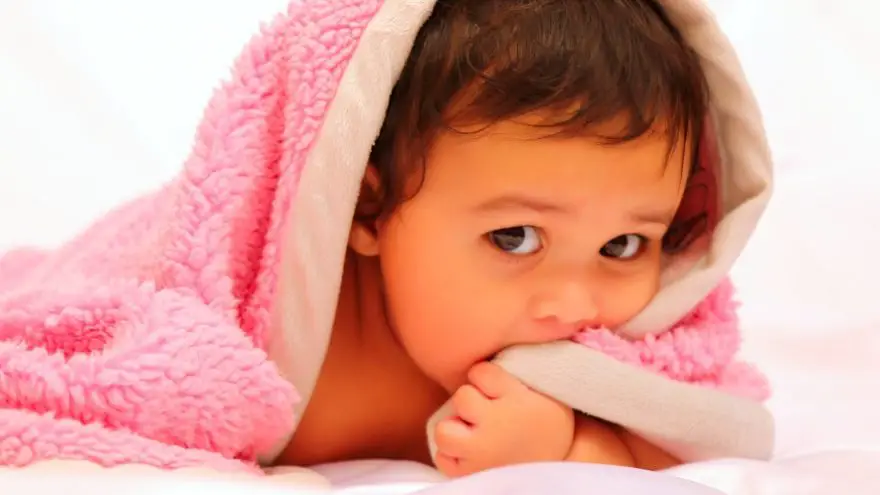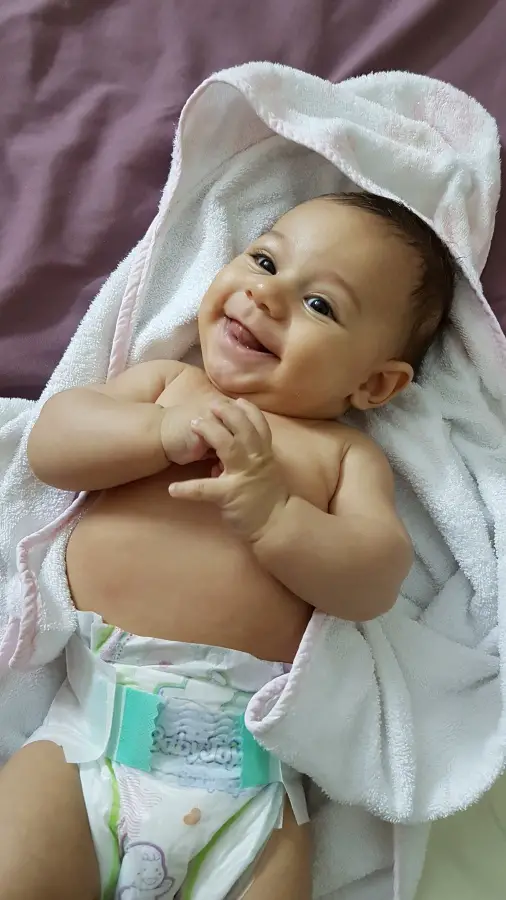Baby’s First Bath: Tips and Tricks

This is your first child and you and your significant other are going to begin to bathe your baby because they finally lost their umbilical cord. Parents are always very nervous when it comes to giving their newborn their first bath. They worry about the baby becoming too slippery and scaring the baby by putting them in water for the first time outside of the womb. Babies cry the first time they are bathed and it’s very normal. They can’t really focus yet and now they feel these hands touching them and the water on their skin and they are scared. It’s harder on the parents than it is your child. Kids are resilient and remember eventually they will love their bath and look forward to it as they grow and learn that you are their safety zone.
The first time you give your newborn a bath can be tricky but eventually, you got this and soon you both will be a whiz at bathing your child. In all reality, a baby only needs a bath a few times a week until they start crawling around and getting dirty from food in their hair or dirt on their feet or all over their body. If they smell funky, they need a bath because formula and food can get stuck in the creases of their neck. When they first come home, you just need to give them a sponge bath because of their umbilical cord. This usually takes a few weeks to heal, then you can give your baby a bath in a baby tub. When your baby can sit up, then they can sit in the regular tub and bathe with your close attention. Babies love splashing in water when they get older and many parents snap some pictures of their baby in the tub for future memories.
Benefits of Baby Baths
After a while, a baby’s bath will be their happy time of the day for both you and your child. It’s a good time to bond and play and laugh and giggle. They know you love them because you are caring for them. Hug them, give them a kiss and tell them you love them. You can tickle them and play with their toes and sing to them during bathtime. This is when your child will listen to your soft voice, see your smile and know what they mean as a child to you.
Bath time is a learning experience for both of you because this is their first experience with water and you can teach them how to play with their bath toys or move their feet and splash their hands. Just make sure they aren’t afraid of the water, never force a child who is frightened. You can talk to them about their body parts so they learn where their hands, feet, tummy, etc is as you wash each part that has a name. Pretty soon they will be talking to you and telling you the name of their body parts.
Bathing is Soothing for Tired Babies
Everyone knows that a nice warm bath is great after a long day of stress. This also goes for your baby plus you can also massage them while you are bathing them. If they don’t like the massage, just gently rub their arms and backs and sooner or later they will let their parents know what they like. Bath time also is a great thing to do before bedtime. The feeling of warm water, a warm room and the feeling of love, safety and feeling secure helps to make baby ready to go to sleep for the night.
 When your baby still has their umbilical cord or if you have had your son circumcised and he hasn’t healed yet, don’t give your baby a bath. You can give them a sponge bath with a baby washcloth and use warm water and avoid the belly button area or the circumcised area until they are all healed. When the time comes for baby’s first bath, start first with a flat surface like a bathroom or kitchen counter area that is large enough. You can even use the floor and lay out a soft towel underneath the baby and continue to wash them gently until you feel they are used to this feeling of being cleaned up. Then start using the baby tub first and your household bathtub after they are able to sit up without assistance.
When your baby still has their umbilical cord or if you have had your son circumcised and he hasn’t healed yet, don’t give your baby a bath. You can give them a sponge bath with a baby washcloth and use warm water and avoid the belly button area or the circumcised area until they are all healed. When the time comes for baby’s first bath, start first with a flat surface like a bathroom or kitchen counter area that is large enough. You can even use the floor and lay out a soft towel underneath the baby and continue to wash them gently until you feel they are used to this feeling of being cleaned up. Then start using the baby tub first and your household bathtub after they are able to sit up without assistance.
Bath Routines
It’s a good time to start a bath time routine after you begin to bathe your child regularly. After a while, your baby will know it’s bath time from going through a regular routine and will also know that either mom or dad is going to bathe them tonight. They also know it’s close to bedtime and you can help them along by using soft lighting, quieting down the house, and keeping the environment calm after bath time is over.
If your baby is grouchy, sick or hungry, don’t give them a bath at the moment. Everyone involved is just going to be frustrated and remember even though bathing your child is relaxing for them, if a different time of the day works better on this particular day, just wash them up and put them to bed after you soothe what is ailing them.
Prepare Bathing Supplies
When it’s time for baby’s bath, make sure you have everything you need around you before you begin. You can’t leave your undressed newborn alone in the tub because you forgot something. Keep soap, shampoo, a few soft baby washcloths, blanket, a nice warm towel and your baby’s bathtub filled with nice warm water. If your significant other is helping you or a family member, make sure you have a camera for one to take pictures if this is their first bath. You’re going to need a clean diaper, clean bedtime clothes, ointment and there are some great lavender soothing skin lotions to keep baby’s skin from getting dry after their bath. You can put the lotion on your child before you dress them. This can be very calming and soothing and the baby will get sleepy fast.
Keep the Room Warm
Your baby loses their body heat very fast when they are newborns because they really don’t weigh much so keep the room warm if it’s cold outside. Once they are dressed or even in a towel, they will warm up quickly after their bath. The temperature should be around 75 to 80 degrees before their bath and you can turn up the temp or even turn on the shower to steam up the bathroom before you begin. If you choose to use the sink or a baby tub, only fill the water to cover the bottom of the baby’s body. Don’t put the baby in a sink or a tub while the water is running. Make sure the water is warm and comfortable for your baby and never too hot or too cold. Make sure you test the water with your elbow or even the inside of your wrist. These spots are more sensitive than your fingers because some people work hard with their hands and the tips become rugged and don’t feel the hot and cold as intense as the sensitive spots.
Hold Baby Firmly
It’s best to slide a baby into the tub feet first, and hold them firmly by using one of your arms under their head, then firmly and gently push their underarm away from you so your other hand can securely hold their bottom. Baby’s can be very slippery and this will make parents nervous but you both will become pros at this quickly. Don’t let your baby sit in the tub for too long because they might get cold or the water may cause skin irritation.
 Don’t use Lots of Soap
Don’t use Lots of Soap
Baby only requires a mild soap on their hands and diaper area. You can mainly just use water unless they happen to be unusually dirty. Start with the face and use a soft cloth or a cotton ball with warm water and gently wipe the eyes from the inside towards the outside corners. Use a clean cotton ball or another part of the washcloth on the other eye. You can get the washcloth wet after the eyes and wash the face, and make sure you get around their mouth and especially under the chin area where milk and baby drool get stuck in the creases of their skin. You can use the washcloth around their ears but don’t use q-tips yet on an infant. You can use mild soap on their face. Wah their body next and be gentle around the belly button if there is any crust left. Parents can wash the genital area and use a clean washcloth and if you have a girl clean between the folds of her private areas and if you have a circumcised boy, make sure his genitals are clean and leave any foreskin alone if you have not decided to circumcise your son. Always wipe from front to back and save their little bottoms for last.
Cradle Cap
Use a tear free shampoo for your baby and you can wash their heads with a washcloth. Lather the scalp and use your fingers to massage the head and be careful of the fontanels or the soft spots of their heads. Be very gentle and if you notice your child has cradle cap which is very common, call your pediatrician who may tell you to try rubbing some mineral oil on their scalp and wiping this off with a washcloth. Make sure you use a soft washcloth for bathing and washing hair and be gentle with their heads.
Rinsing
After you are done bathing your baby, it’s time to make sure you rinse the soap off their body. Hold your baby with one hand and take a cup of warm water and pour it over the back of their head. Try not to get any in their eyes and they might not like the rinsing off process at first but they need the soap off their heads. Remember to hold your child with their head over their basin. Make sure you don’t rub their skin with the towel, make sure you pat their skin dry with a nice warm and soft towel and dry every area of their body.
All babies are not going to like baths in the beginning so don’t force them to take a bath. You can go back to sponge baths for a while, then try bathing them again. Eventually, your baby will be ready for their bath and will love it after awhile. Remember never leave your baby alone in the tub and always keep one hand on them firmly because they are strong and can slip really easily out of your hand.






